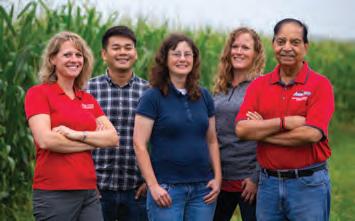Poultry litter brings long-term benefits The use of poultry manure as a fertilizer has been found to improve crop yields and soil health over time. by Natasha Hoover, Ji Yeow Law, Leigh Ann Long, Ramesh Kanwar, and Michelle Soupir
A closer look at the nutrients After 20 years, Bray-P analysis indicated average phosphorus (P) levels of 317 ppm (parts per million) in the topsoil of the plots treated with poultry manure. Elevated phosphorus concentrations in topsoil pose a risk for contributing phosphorus to surface waters during storms. When soils carry high P levels, conservation practices should be used to reduce erosion. Producers can also con-
Figure 1: Corn-soybean phase (1998 to 2009)
28 | Journal of Nutrient Management | February 2020
F2 28-29 Q1 2020 Polultry.indd 2
timeters (cm) (48 inches) and analyzed in five increments: 1. 0 to 6 inches 2. 6 to 12 inches 3. 12 to 24 inches 4. 24 to 36 inches 5. 36 to 48 inches
health in the manured plots compared and plots fertilized with UAN. Such benefits included more total soil carbon, particulate organic matter, and improved soil structure. Greater amounts of soil organic matter enhance soil cation exchange capacity, which provides greater long-term soil fertility. Particulate organic matter is partially decomposed plant material that stabilizes soil particles by binding them together into aggregates, which minimizes erosion, improves root penetration, reduces bulk density, and enhances water infiltration and soil water-holding capacity. It is also a source of organic nitrogen (N), which can be slowly released for improved soil fertility. Deep-soil core samples were collected in the fall of 2017 to a depth of 120 cen-
Nitrate-N, mg L-1
long-term study of the impacts of continued poultry manure application on soil health and nutrients, water quality, and crop yield response with economic analysis was completed in the fall of 2017. The 20-year study was initiated in 1998, with a 12-year corn-soybean phase (CS Phase) from 1998 to 2009, and an eight-year continuous corn phase (CC Phase) from 2010 to 2017. Poultry manure was applied to plots at a low or high rate during each phase; a crop-recommended rate and a double-application rate during the CS Phase, and a crop-recommended and half-application rate during the CC Phase. Urea ammonium nitrate (UAN) was applied at the crop rotation-recommended rates of 150 pounds per acre during the CS Phase and 200 pounds per acre during the CC Phase. The goal of the study was to provide a long-term assessment of the environmental and economic affects of poultry manure application in tile-drained agricultural systems of the Upper Midwest. The results provide a comprehensive overview of poultry manure’s impact on agroecosystems, supporting on-farm decision making and watershed level nutrient management strategies. After 20 years of manure application, there were measurable improvements in multiple parameters of soil
40
■ Low poultry manure
■ High poultry manure
■ UAN
30 20 10 0
Pre-application
Post-application
Growing season
Late season
Stage of field management or crop growth
jofnm.com
1/17/20 9:49 AM






